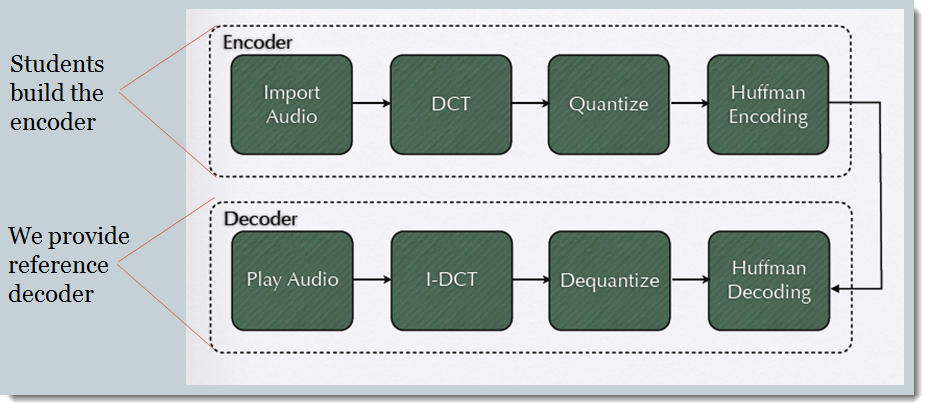- Document History
- Subscribe to RSS Feed
- Mark as New
- Mark as Read
- Bookmark
- Subscribe
- Printer Friendly Page
- Report to a Moderator
- Subscribe to RSS Feed
- Mark as New
- Mark as Read
- Bookmark
- Subscribe
- Printer Friendly Page
- Report to a Moderator
Goal
The goal of this lab is to gain an understanding of the different components involved in source coding. Specifically, we will be dealing with the Discrete Cosine Transform (DCT), sample quantization, and Huffman coding.
Lab Overview

Course Overview
This lab is from a course developed at Stanford University entitled Building Networked Systems. The course was first taught with a trial group of students in the Spring 2011 quarter. With the software/hardware combination of LabVIEW and the NI USRP, students were able to build and explore each element of a complete communications system signal chain. The course progression covered topics including channel coding, modulation, demodulation, timing recovery and culminated with students building their own protocol.
Course evaluations affirmed that students were highly engaged in and benefited greatly from the EE 49 class. “The course evaluations for our class were fantastic,” said Katti. “Students rated the class 4.94/5.0, likely making it one of the highest rated among all classes in the School of Engineering at Stanford.” To learn more about the course view the case study entitled: Designing Hands-On Wireless Communications Labs With the NI Universal Software Radio Peripheral and ....
These materials are considered a work-in-progress and reflect the first run of the course. The course is anticipated to run again in the Spring of 2012.
Additional Labs from the Course
EE49 Lab 1: Source Coding Lab: Cosine Transform (DCT), sample quantization, and Huffman coding
EE49 Lab 3: Introduction to Modulation: BPSK & QPSK
EE49 Lab 4: Introduction to Demodulation and Decoding: BPSK & QPSK
EE49 Lab 5: Building a Wireless Packet Transmitter and Receiver
Required Components
LabVIEW Full or Pro
Experiment
The PDF laboratory procedure is attached along with starting-point VI's for the students.
LaTeX source is included so that it can be customized by the instructor.
Contact Information
Author: Dr. Sachin Katti, Jeff Mehlman, Aditya Gudipati
School/University: Stanford University
- Mark as Read
- Mark as New
- Bookmark
- Permalink
- Report to a Moderator
Me podrias decir cual es la contrasena ya que algunos VI me la pide para ver su programacion, y no la se?
ErikL escribió:
Goal
The goal of this lab is to gain an understanding of the different components involved in source coding. Specifically, we will be dealing with the Discrete Cosine Transform (DCT), sample quantization, and Huffman coding.
Lab Overview
Course Overview
This lab is from a course developed at Stanford University entitled Building Networked Systems. The course was first taught with a trial group of students in the Spring 2011 quarter. With the software/hardware combination of LabVIEW and the NI USRP, students were able to build and explore each element of a complete communications system signal chain. The course progression covered topics including channel coding, modulation, demodulation, timing recovery and culminated with students building their own protocol.
Course evaluations affirmed that students were highly engaged in and benefited greatly from the EE 49 class. “The course evaluations for our class were fantastic,” said Katti. “Students rated the class 4.94/5.0, likely making it one of the highest rated among all classes in the School of Engineering at Stanford.” To learn more about the course view the case study entitled: Designing Hands-On Wireless Communications Labs With the NI Universal Software Radio Peripheral and ....
These materials are considered a work-in-progress and reflect the first run of the course. The course is anticipated to run again in the Spring of 2012.
Additional Labs from the Course
EE49 Lab 1: Source Coding Lab: Cosine Transform (DCT), sample quantization, and Huffman coding
EE49 Lab 3: Introduction to Modulation: BPSK & QPSK
EE49 Lab 4: Introduction to Demodulation and Decoding: BPSK & QPSK
EE49 Lab 5: Building a Wireless Packet Transmitter and Receiver
Required Components
LabVIEW Full or Pro
Experiment
The PDF laboratory procedure is attached along with starting-point VI's for the students.
LaTeX source is included so that it can be customized by the instructor.
Contact Information
Author: Dr. Sachin Katti, Jeff Mehlman, Aditya Gudipati
School/University: Stanford University
